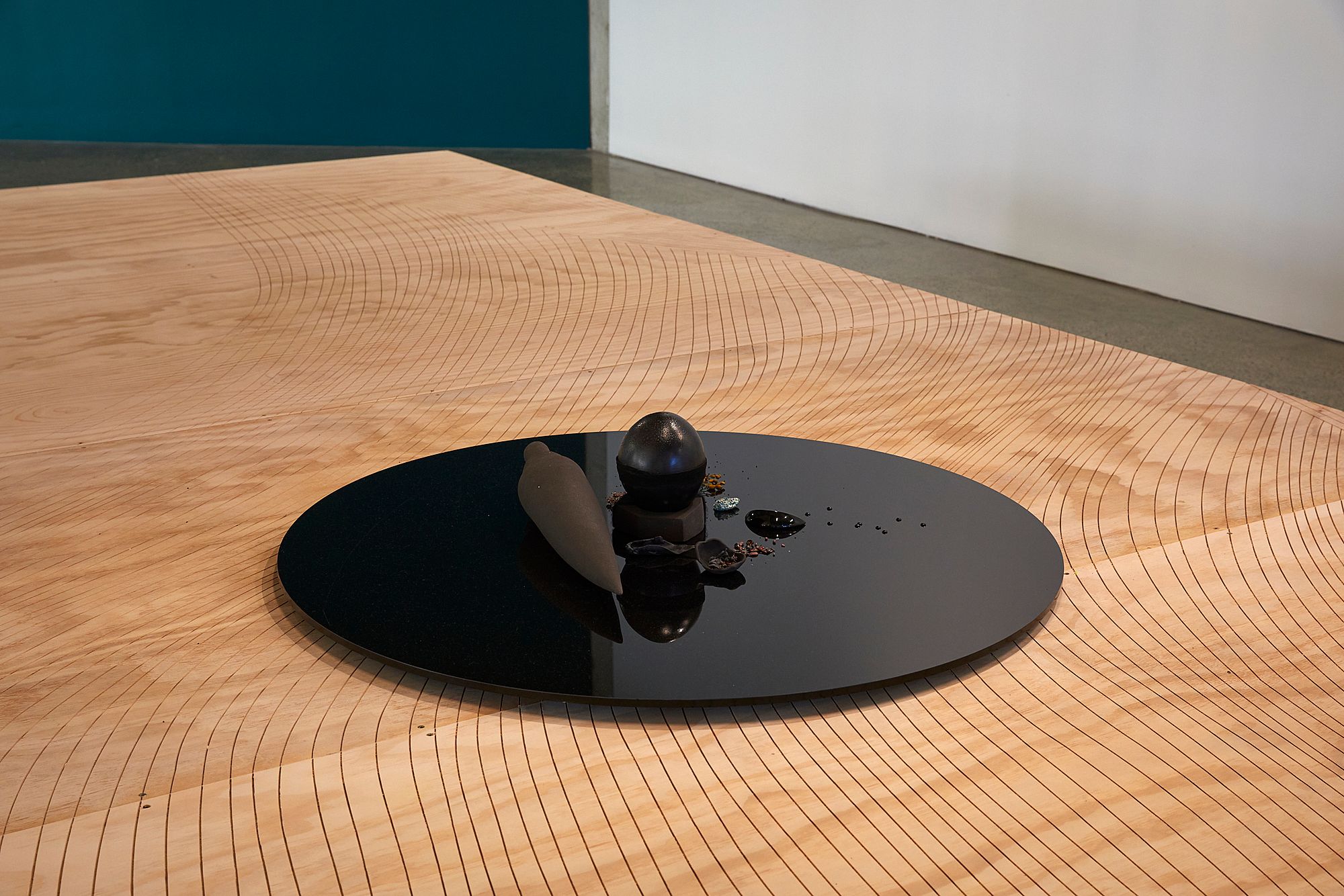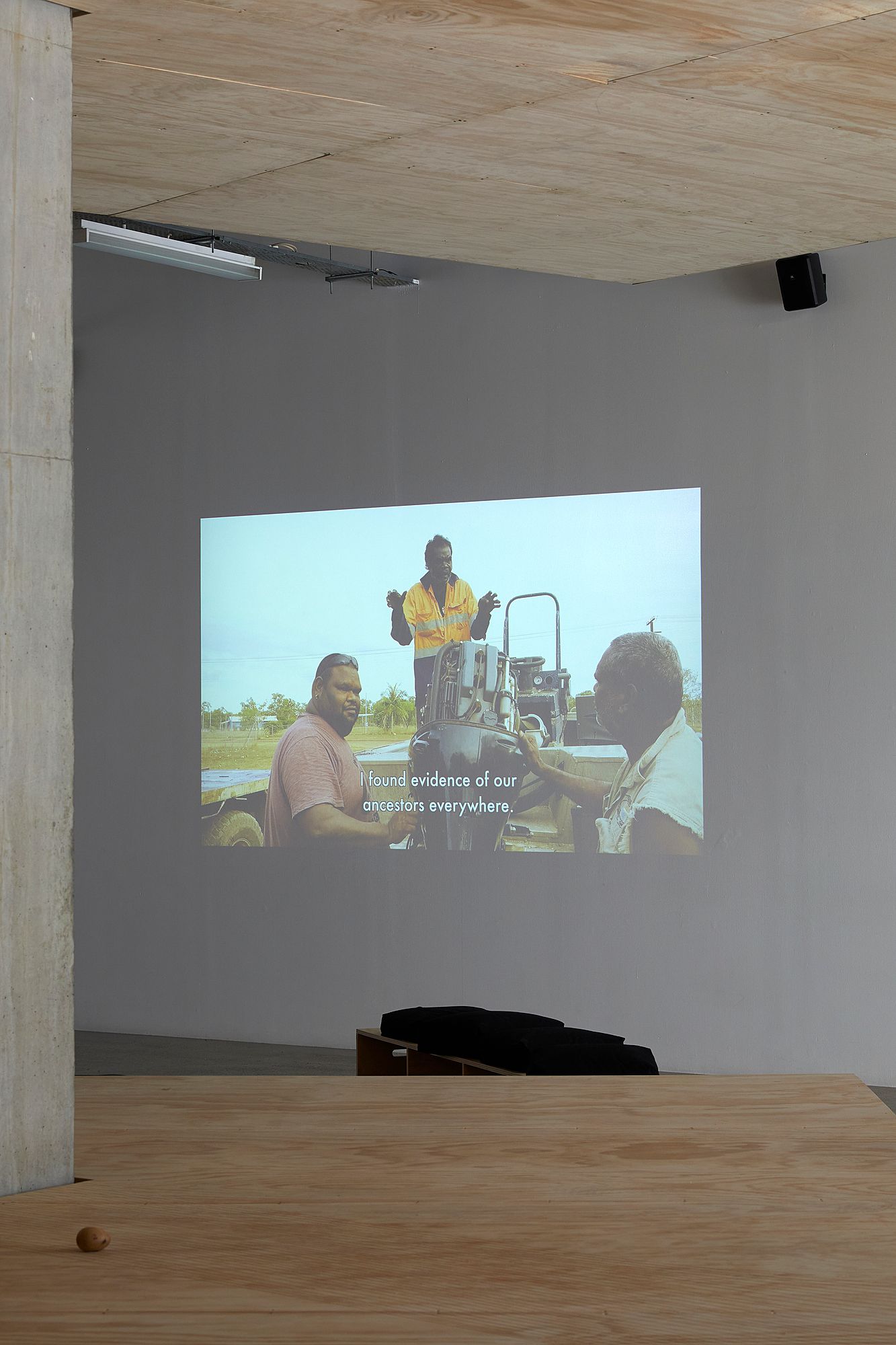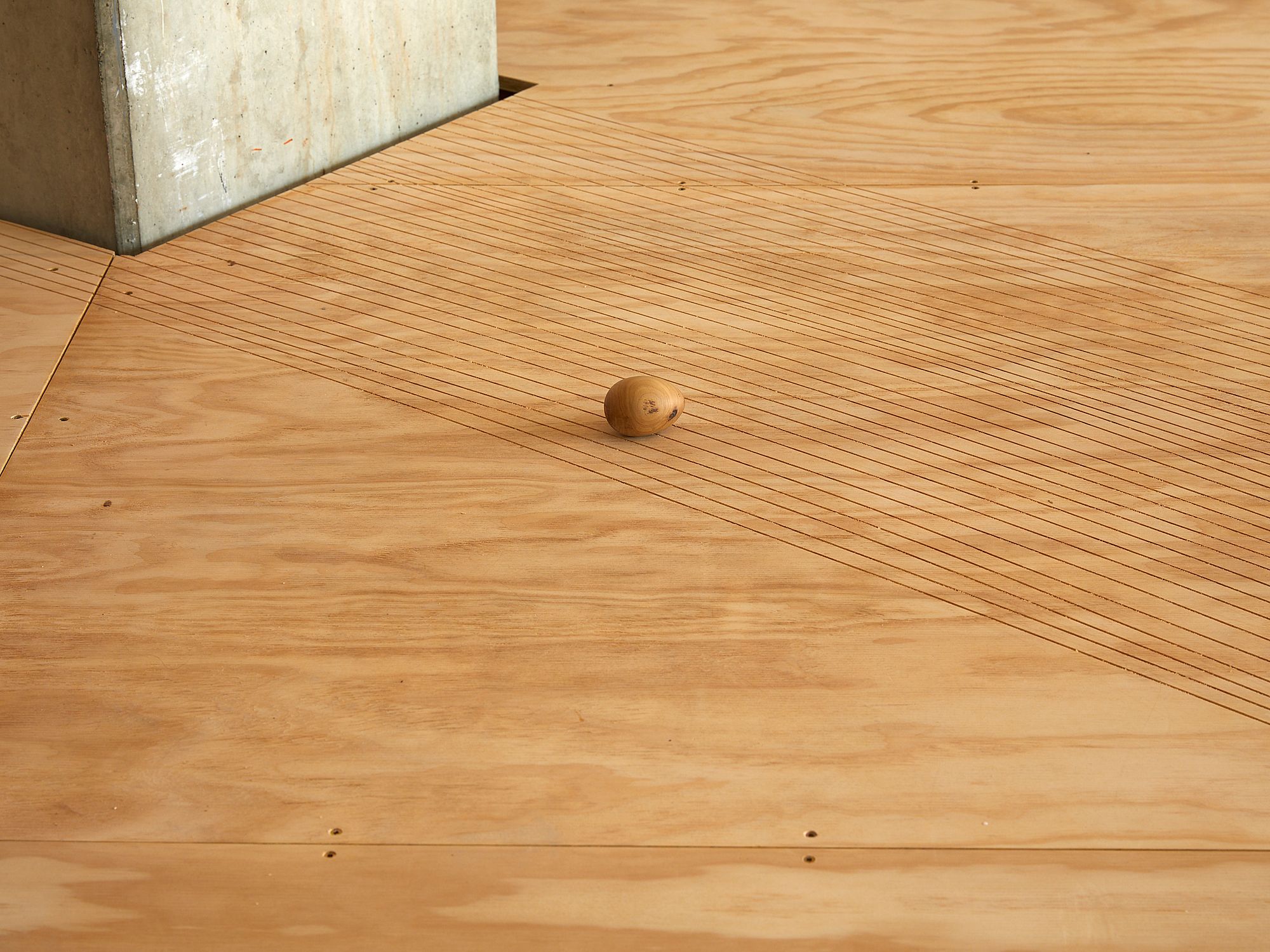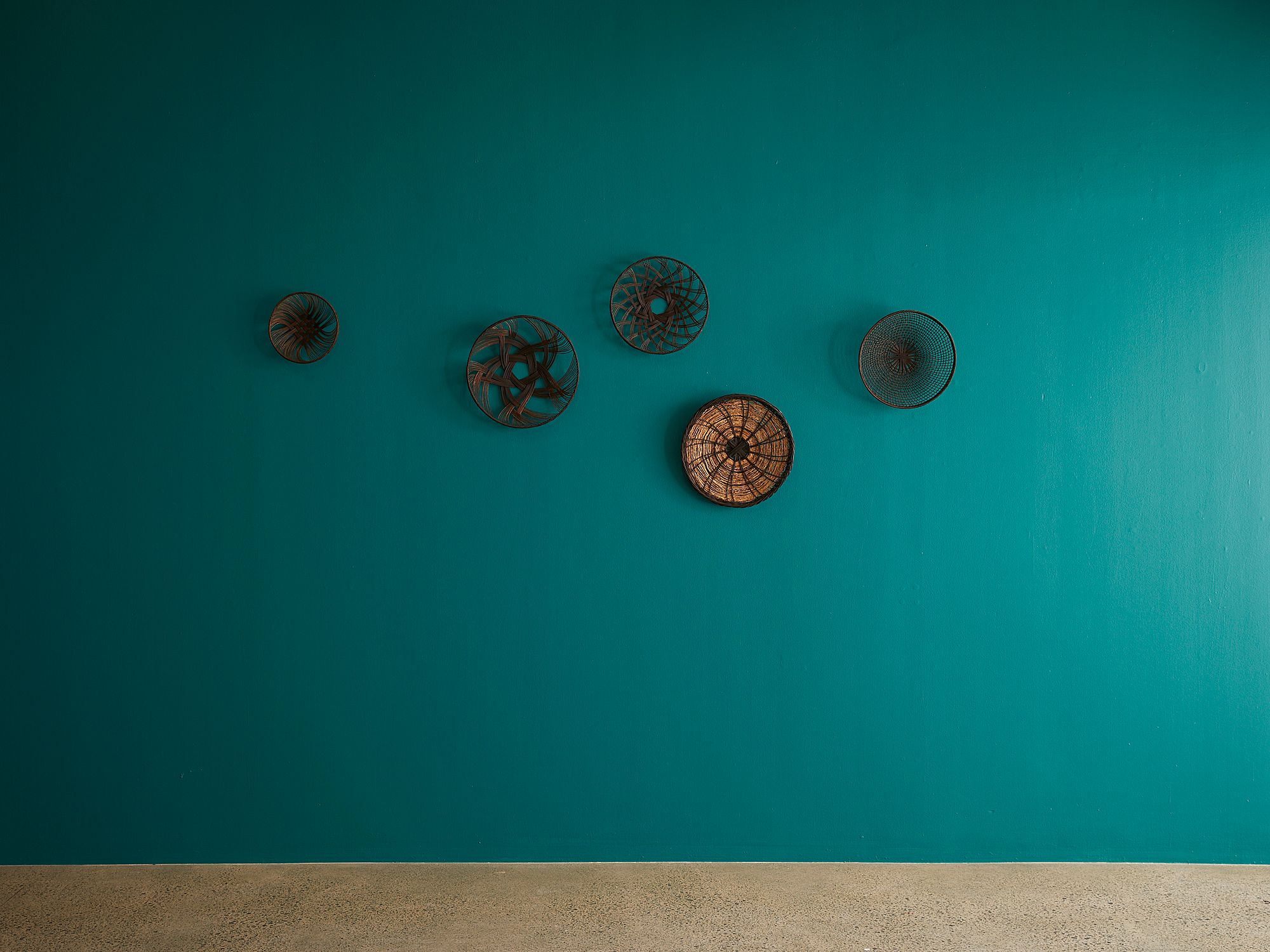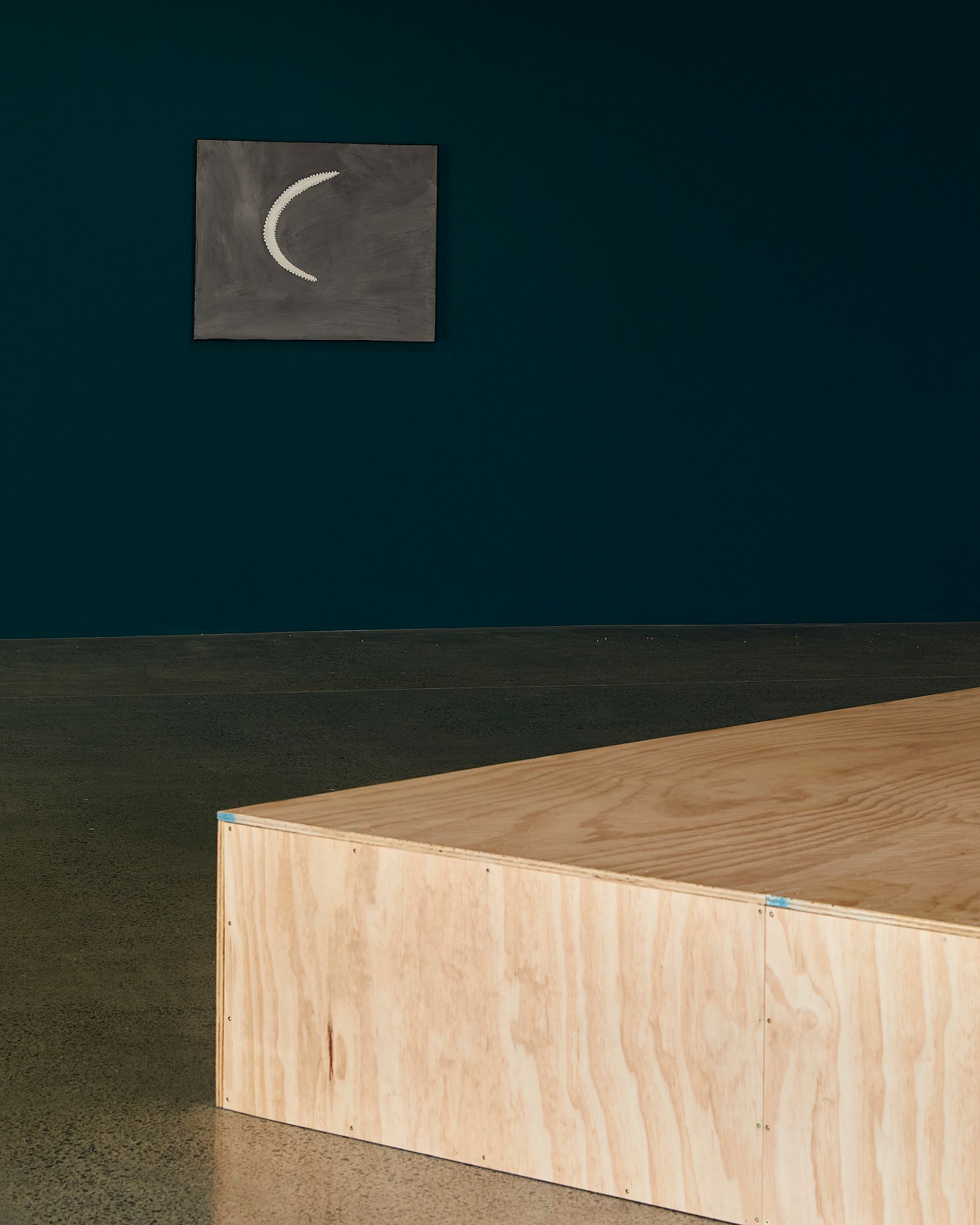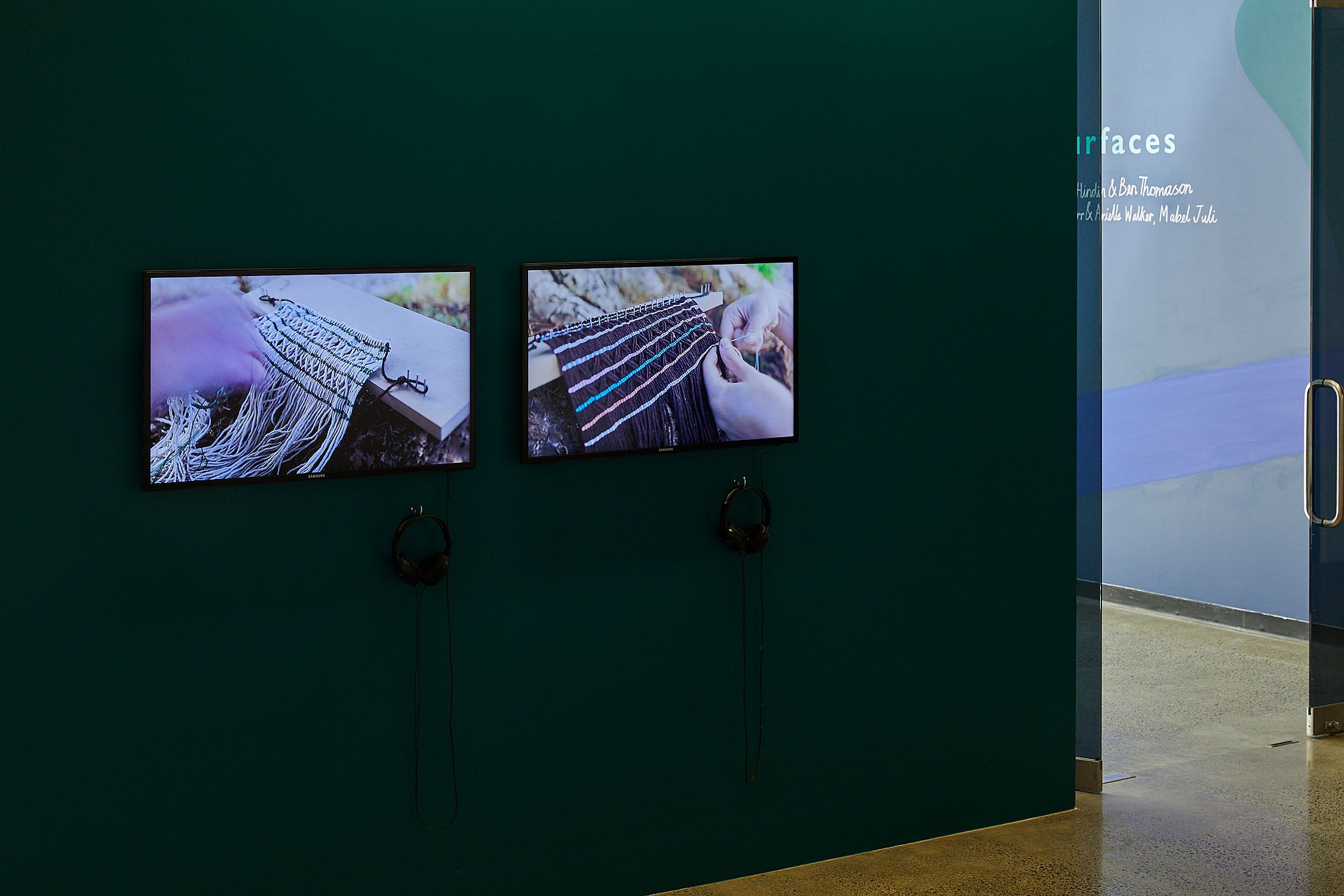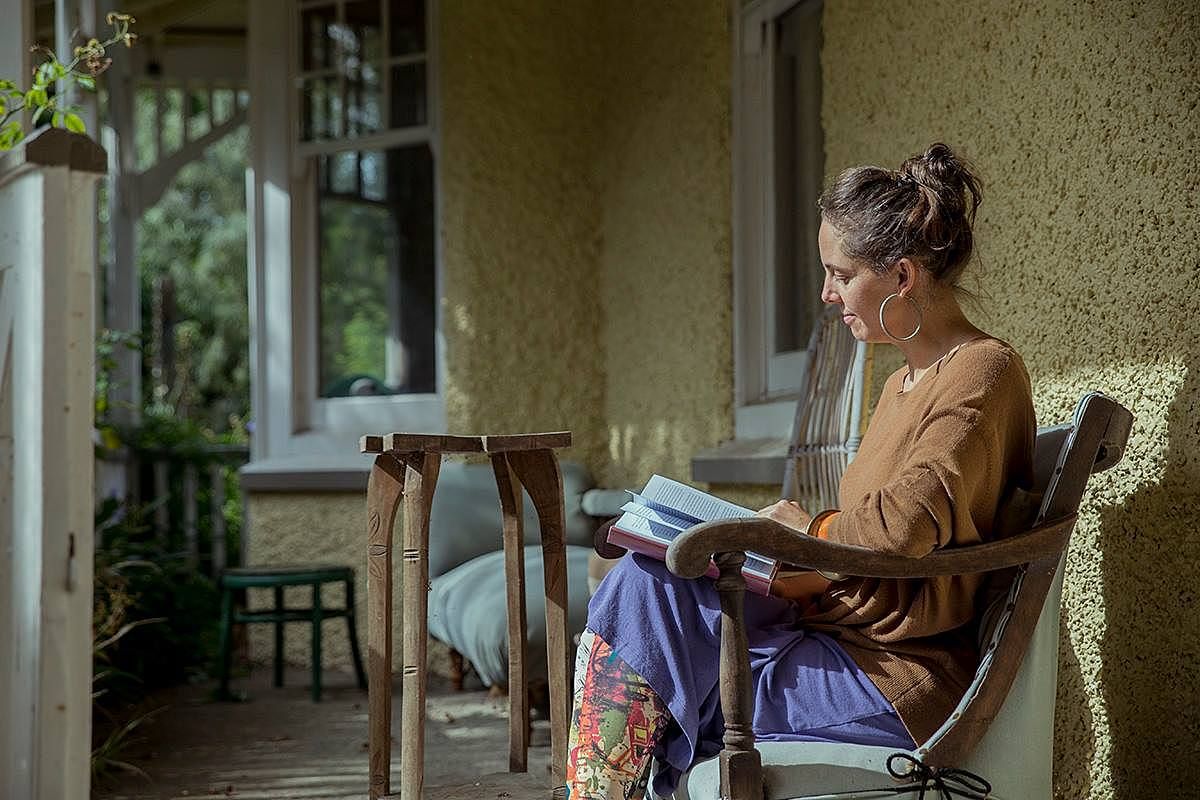Taniwha in the Room: A Response to Speaking Surfaces, Part Two
This is a story in two parts – a waning and a waxing – of Cassandra Barnett's attempt to complete an essay about Speaking Surfaces at St Paul St gallery over lockdown. Part Two focuses on works in the space by six different artists and collectives.
Returns
I’m here again, in my bedroom in Te Whanganui a Tara, as we emerge from lockdown, blinking. I’m here again at ST PAUL St Gallery before lockdown, on Rangipuke above the Waihorotiu Stream in Tāmaki, time-travelling. Feeling buoyed by the friendly, oceanic presence that Sapati Mossiah Avei Fina’i’s installation VĀWĀ has become for me. Seeing the art, at last.
-- add yourselves to the circle --
-- draw your pepehā --
-- hear ours --
we have new friends to weave into our rōpū today; I gesture to yesterday’s drawings of my son, our maunga, our marae, our links to Ireland and Africa, our tūpuna swooping in from many lands, and I tell what I just heard in Matiu’s nguru, the flutes and pipes and breaths of all those ancestors – their different ways of blowing notes into the world riding in, landing here with us; then our four new friends introduce themselves, including Rachel whose soundscapes fill the gallery, then Charlotte leads us again around the space, smudging as she goes, and introducing the artworks and I’m glad to hear the names spoken with live voice, for now Mossiah, Jen, Ruth, Nikau, Ben, Mabel, Karrabing, Emily and Arielle are in the room, I can hear them, I feel them, the makers, their hands, their mahi in the room
Stars
Nikau Hindin, Ben Thomason, wall vinyl
I’m floating towards a work on the far wall of the gallery. It twinkles. A large rectangle with graphic patterns in red, white and black. Across the bottom, rows of niho taniwha. Above them, vertical black lines strung with sparse, irregularly distributed little triangles. Up close, small numbers, scrawled beside each triangle. The work speaks of something more than tukutuku and tāniko. It’s pregnant with visual information I can’t decode alone.
The roomsheet explains that the numbers give the declination on the horizon where each of these triangle-stars rises. The work is a key for learning the Star Compass: ancient knowledge for ocean wayfinding using the currents, winds, waves and other stars – tohu o te rangi me te moana. My heart beats faster. I scan the numbers and names and lines, absorbing the vastness of the task and the need to be physically in the right wā for this work – somewhere with visible eastern horizons, sometime before daylight. Later I watch Hindin’s Instagram Lives, trying to sink deeper into the star knowledge.
I feel called by these tohu towards my sense of a puna. The image soothes my yearnings for the star knowledge of my own rohe. It’s bittersweet: so close, yet so far. In another online video Hindin says, It’s about taking celestial bodies and translating them into this physical world.It’s her way of beating a path through the blankness that has refused our knowings, our presence.
Although this work is vinyl, Hindin often paints her star maps on aute (paper mulberry) cloth, which she prepares according to patient, slow, customary processes. I imagine knowledge enters the body differently when it is entrained to manual rhythms and seasonal rhythms like this. I find in this glacial month we’re having a tiny clue. Is this what our slow mātauranga, from aeons before mass reproduction, feels like?
Nikau Hindin (Te Rarawa, Ngāpuhi) and Ben Thomason (Ngāti Raukawa ki te Tonga); Jen Bowmast, Psychopomp, 2018.
Whenua
How is the constant presence of VĀWĀ affecting my viewing now? It’s making my vision sharper. Albert Wendt says the vā is a space that holds separate entities together. From this I gather it is not a melding of those entities, not a denial of their joys, sufferings, singularities. Not a fluff space, fuzz space or blur space. The vā is not assumed unity, not utopian.
Again Toni Morrison’s 20-year-old writings on globalism resonate for these global-pandemic times:
“Empire,” “internationalism,” “one world,” “universal” – all seem less like categories of historical trends than yearnings. Yearnings to corral the earth into some semblance of unity and some measure of control … Globalism has the same desires as its predecessors. It too understands itself as historically progressive, enhancing, destined, unifying, utopian.1
VĀWĀ is not a philosophy, not a system. It’s grounding, earthy; working against such ideological whiteout. In the vā it helps cultivate, perhaps meaning and connection occur via an acceptance of differences. Perhaps the space between permits people (and artworks!) to speak their differences and sit with the differences of others.
But how? Here’s a new physical ground, VĀWĀ: a new place to walk or sit, 70cm above the floor. But how does VĀWĀ help generate the less tangible, but also grounding, experience of being in the vā? My hunch: by pointing back to the whenua and the wai; to earth, sea and sky. As Emalani Case says, the vā must begin by looking down.
VĀWĀ’s topographic contours point to Papatūānuku. Its plywood calls back to the trees. Its daily changing moon-cycle points to our place within Ranginui. Its reference to culturally specific, localised cosmologies reminds us where within Papatūānuku we are. Its provisional nature reminds us VĀWĀ is responsive, and must be constantly activated anew.
Indeed VĀWĀ comes with human activations, like the Creative Wānanga led by Jack Gray. Activations reminding us to mihi, and acknowledge the ground we come from and the ground we’re standing on now. We’re on Rangipuke, following the flows of Waihorotiu. We’re manuhiri in the rohe of Ngāti Whātua.
Really, VĀWĀ is a path back to the old ground. A path that cracks open the fake ground – the institutional poker-face, the ideological blankness – so what was here all along can shine through. [H]uman, animal astronomical or celestial presence.2
I feel repositioned. Summoned to a place demanding my alert, present, active, full-bodied engagement. That’s the trick enacted between VĀWĀ and Jack’s wānanga-ceremony. Only when I’m feeling called, and seen, and activated in this way do my senses tune in to really seeing all the other brave and singular presences in the room. It takes a lot of set-up – especially inside an institution. Things need to be undone as well as done. But this is these artist’s due. This is everyone’s due.
-- in a well-spaced, socially-distant line, walk --
the doctor leads us downstream now, no water, no bowls, and everyone follows – except Charlotte, who must remain at the gallery; just across the road, he pauses
Karrabing Film Collective, Wutharr, Saltwater Dreams, 2016.
Nyudj
Karrabing Film Collective, The Mermaids, 26’29” video
We’re walking along a road with a boy. To the left of him is bush, burning. He’s alone with this shit, in an old muscle shirt, bush on one side of him, sealed road on the other. Alone with the crackling flames and the slow wooing-wobbling soundtrack and the sepia-underlaid colour-separation effect. He’s alone but talking, maybe to us viewers, maybe to the camera, maybe to invisible companions. He’s saying Look at this fire. Big one eh? We are somewhere both timeless and viscerally present. All that’s been lost on the left; the payment, in tarmac, on the right. I say we, but his ‘we’ is not mine. I say we, wondering if this is a space where it’s possible to say we without erasing the identity of each member of this we.
Other images in this film are starker, their action more violent, their cultural realities more sharply cut. White people are identifiable by their voices, the industrial buildings they inhabit and the shellsuits hiding their faces. They are health-panicked, allergic to the outside, and bring a grim, roughshod, institutional brutality to the black people whose immunity they hope to steal. The world is ending day by day, says an auntie’s voice. Outside is bush and black people and spirits and biohazard signs and life and shell-suited white predators and all of time. The end of the world. / Yeah, the end of the world.
It's scary, uneasy. And uncannily close to our own moment of bushfires and biohazards. The visual signs of danger plus the layered audio – buzz of blowflies, snap of grasses, honk and burble of pelicans and other creatures and ancestors – cook up a heady mood. But though every shot is multiple, shaking and trembling with life, the pace is always slow. And the dominant tongues and points of view are black – sometimes living, sometimes past, often both at once.
The sensory rhythms on this screen are loose, expansive, muddy, unpolished. A million miles from our shiny daily Covid-19 media updates. The latter masquerade as the elimination of unease; yet communicate a paranoiac hyper-control. Everything is in hand! No breath of doubt please! In The Mermaids, you can almost hear the black laughter when the white voices speak: This area is under a level two biohazard quarantine. Please limit contact with other personnel as much as possible. / … there has to be some reason the land is poisoning us and not them. In contrast to ubiquitous sterility, The Mermaids’muddiness is the most reassuring thing I’ve seen.
Karrabing Film Collective, Wutharr, Saltwater Dreams, 28’53” video
In Wutharr, we see nyudj, or ancestor spirits, sitting under the grasses. They mutter and fuss. They never visit us, let's punish them! Their voices are high, childlike, sing-song, almost parodic. A bit like a good joke: while you’re looking the other way, distracted by a red herring, stereotype slides out and spirit slips in. If you reach this way then that, you can create a crack wide enough for something real to pass through. Even the ancestors are laughing. It makes me believe.
Wutharr, Saltwater Dreams is all about cracks. Every member of this community has a different opinion about why their boat broke down: The ancestors must have broke the motor. / If you believe in the lord your boat will start. / I dunno about the lord but I know about spark plugs. Despite these differing estimations of the ancestors’ power, the men all agree, We can't say their names … We're in the boat!
All the versions are here, including the version where you can believe a customary thing and a conflicting, coloniser thing at the same time. I feel this, hard. Yet tentatively. I'm a middle-class urban Māori with plenty of privilege; there’s little overlap between our lives. I don’t ever experience this durational atmosphere, nor the slow, unending calm of the people in these films. But I know well how colonisation births us broken into fissures we spend our lifetimes fighting out of.
Karrabing’s many-handed, many-timed cinema is like bathing in a warm waterhole or estuary. Disease or no disease, it feels like truth. It feels like our lives. Like mine and my son’s, lived between Māori, Pākehā and Rwandan joys and sufferings. A cultural devastation is apparent. A collective cultural confidence of vision is too. Dreamings and shirty ancestors are never far. This time repeats and loops. The end of the world has a different meaning here. It’s absurd, even funny. The end of whose world? We try to warn white people. / They don't understand the consequences of violating black law.
Sapati Mossiah Avei Fina’i with Speaking Surfaces project team, VĀWĀ, 2020; Nikau Hindin (Te Rarawa, Ngāpuhi) and Ben Thomason (Ngāti Raukawa ki te Tonga); Jen Bowmast, Psychopomp, 2018; Karrabing Film Collective, Wutharr, Saltwater Dreams, 2016; The Mermaids, or Aiden in Wonderland, 2018.
Territories
We’re back in lockdown in Ngaio. We’re moving into uncharted territory. But our leaders’ grounds are firm. The statesman-style delivery. The legacy TV. The kindness. They are charting this territory by bringing back the old. Old media tropes. Old power tropes. Old words (unprecedented, extraordinary; enemy, soldiers, fight, battle). Reinvigorating the language of war. As if something unexpected justifies a regression.
And like troopers we must chart the territory with our bodies; our facemasks and our soaps; our stasis. But we (some of us) chart it also with dancing, gardening, roadblocks and rongoā. We are more than islands, more than passive, obedient recipients of the screen-glow’s directive. We take responsibility for our own wellbeing, however we can. We know ourselves best.
This is about the aesthetics of power. This is about where the cracks are, and what escapes. What might get liberated at times like this. Loud power is only one kind of power.
Jack once said, One of the things I'm interested in is to be quiet in my power, generous in my offering and humble in my outlook … to shift a bunch of stereotypes around the perceptions of what happens when people who have been erased from the situation finally get a microphone ….Quiet power and quiet resistance speak to me.
-- listen --
-- focus on what your ears hear --
I hear birds, motorbike engines, building work overhead, chatter, laughter, then the doctor stops us again, tells more stories, about Waihorotiu flowing down to sea, about where the foreshore once was; about the making of Fort Street – once Fore Street – and Beach Road and, earlier, what a mission it was to haul a waka up the beach at Te Toangaroa Mechanic’s Bay; about what our tūpuna knew, about what we bring with us and the importance of activating their knowledge now, now of all times
Seeds
Jen Bowmast, Calls herself into being / Psychopomp, installation
I’m peering at a scattering of earthly jewels. Droplets of form in copper, obsidian, clay, bronze, silver, wax, wood, wool. Tacit, witchy things. Natural materials moulded by human desires into tiny seeds, an egg, an arrowhead-pendulum. The many textures of Papatūānuku are relieving here, amongst all the squares and screens. But why these things? They sit on a reflective circular black disk down one end of VĀWĀ. A dark moon, just beyond arm’s reach.
Nearby on the floor sits a much larger, shining black sculpture. A biomorph like nothing Henry Moore ever made; imperious counterpart to his woman-objectifying sculptures. It’s so shiny it looks wet. Like the pounamu in Te Papa, it calls out to be touched. It’s an anchor, a kuia, a source of endless potency for the forms downwind of it. These are things for querent hands. Votive things, supplicant things, charged things. Don’t mess with us, they whisper.
One thing I like about art in the European esoteric tradition is that it centres a decolonising seam to be found inside of Western culture. Seams like this help my inner manuhiri befriend my inner tangata whenua. They might hold clues for other manuhiri too – something belonging to them – as they step up as allies of decolonisation.
Toni Morrison writes: If my work is to confront a reality unlike that received reality of the West, it must centralize and animate information discredited by the West – discredited … because it is information held by discredited people, information dismissed as “lore” or “gossip” or “magic” ….3
The divinatory knowledge practices Bowmast draws on (including scrying, molybdomancy and psychic readings) are sometimes discredited by the same rationalist-imperialist zeal that oppresses non-Western knowings. Witches, mediums, clairvoyants, tohunga: each have had their turn as enemies of the crown and the Christian-secular state. Some more devastatingly than others, of course.
The roomsheet tells me Bowmast’s materials go through transformational processes as they are formed – glazed and fired clay, cast bronze, wax dipped plant materials, carved wood … reshaping their surfaces and appearance … As artefacts that carry energies of the making processes, they can be seen as transitional objects located physically here, now and connected to other places and times.
Taonga also connect people across space and time, albeit through vastly different processes. Like taonga, Bowmast’s miniatures elude capture by colonial power structures. Like taonga they are physical tohu of earth, sea and sky, but carry unseen presences too. These, alongside Ruth Castle’s works, are the physical artefacts in the room. I’m glad they’re not actual taonga, not Māori ‘artefacts’ this time, but sacred tools of a different order. Come as allies to help bear the burden of revival and reclamation.
I’m reaching, stretching for relationship across difference. Because the vā asks me to.
Jen Bowmast, Calls herself into being, 2020.
Handtools
I am in the master’s house. Standing on a provisional ground that dismantles the surrounding institution then dismantles itself, pointing to earth and sky. Perhaps VĀWĀ is also a tool. Like a crowbar: for pulling nails out but it can do so much more. Needs only the strength of your arm and Voila! The edifice begins to crumble. I’m letting myself imagine, for a moment. Letting myself feel that feeling. I need this. Isn’t this what art is for?
And whose tool is this? ST PAUL St Gallery’s? Fina’i’s? The artists’? There are no masters, no enslaved, here now – masters and slaves are spots in the system, spots inside us but not equal to us. I imagine this temporary community of people (artists, dancers, curators, writers, students, teachers, parents, friends…) gathering all their differences. Inventing and then activating this tool. Right here on Rangipuke. A spring bursts up. Bubbles out of the ground, breaks cover. Sends little rivulets (us!) off down the old waterways, free again to flow in that cyclical, uncontainable way of water. It’s temporary. But I need to imagine this.
-- look --
-- use all your recording devices & your apps to gather sign of life --
we walk and walk as I trail slower and slower behind, my photos favouring leaves, my videos favouring Tāwhirimatea, and I want to gather the people too, the walking people, the mask-wearing people, the busking people, the street-sitting people, and though my conscience forbids it a few do sneak through; but mostly I notice the nonhuman lives, mingling with these people not yet locked down
Containers
Ruth Castle, Check Pattern dish, Sunflower Pattern dish, Spiral dish, Bangalow Palm dish, Fish Basket dish
I’m standing transfixed by Ruth Castle’s handwoven baskets. They adorn a teal-coloured wall near the gallery entrance. Each one a piece of sacred geometry, solving a riddle known only to the artist. They’re not kete. Not really baskets either. They’re bowls and they’re not bowls. They’re mandalas. The roomsheet calls them dishes. They won’t hold water. They have no intention of containing what cannot be contained. They too come readymade with holes and cracks for the real to fall through. Built-in escape hatches.
They’re so beautiful, with their intricate, harmonious compositions and warm touchable rattancore and bangalow palm fibres. I’m happy to stay with them, going nowhere too. But then, briefly, I see ginormous yellow melons or mangoes lounging in them. A slapstick, preposterous vision against their lightness. A reminder that they too have mahi to do, and they’re good for it. Again I’m glad they’re not raranga Māori, not our taonga this time. This vā is wide, and needs Pākehā artists too.
Check Pattern dish, Sunflower Pattern dish, Spiral dish, Bangalow Palm dish, Fish Basket dish, all 2019. Presented with thanks to Masterworks Gallery.
Jokes
I am worrying, nonetheless. How to pass this free feeling on to my son? I worry that all our ceremonial play, all our work and all our aroha, are not enough. It won’t hold. Imperialism and institutions are like the undead – they have ways of preserving themselves. Paranoia is contagious. Our self-preservation must beat theirs. It must prevail.
Is this VĀWĀ, this vā-place, a joke or a serious intervention? Or neither? It nibbles at the toes of the university. I am torn between taking seriously and not taking seriously. There’s something in this that feels good. A lightness, a koan-ness. A moving away from the gravitas of academic enquiry, towards humour and poetry. Towards things – locked-down spaces, hermetic seals – being chipped and cracked open for us, making room for change. But so much more is needed for these cracks to hold.
-- share what you found --
Abbie shares her circle obsession, which started yesterday and is still going today; Matiu shares that he filmed only Abbie, with a quiet dedication which she bore gracefully; Rachel shares, Jack shares, I share, scrolling quickly because I’ve taken too many; another shares that she chose not to photograph, likes to leave her phone alone; another shares that she photographed only food – her dog was choosing the signs of life; another shares her hamburger snaps and her hope that veganism’s time has finally come
Countries
Mabel Juli, Garnkiny Ngarranggarni (Moon Dreaming), painting
I am gazing at the moon. Juli’s painting is made of mawandu or white ochre from the Kimberley area where her Warmun community live. The image shows a white sickle sitting on a grey ground, and tells of Garnkiny, the Ngarranggarni ‘big story’ of the moon. But the white clay, formed along certain riverbeds, is as significant to the work’s meaning as the imagery.
The roomsheet says Juli’s story knowledge includes understandings of social and ecological relationships, about forecasting weather and adaptation to climate. It makes perfect sense to me that the clay itself, coming directly from the local ecology, would speak to environmental, climatic and social knowledge in ways that exceed the image. But I don’t want to speculate further about those connections, that knowledge; I’d be wrong.
With Hindin and Thomason’s stars I leaned in with questions. With Juli’s moon I prefer to hold still, ask for nothing – just breathe the air. This knowledge has a space here, but is visiting. Sharing its earth and its sky with ours. I hope it feels held and safe here. I hope it feels good company, as I do. I hope it can dance with us.
Juli simply says of the Moon Man, My mother and dad used to take me everywhere, walkabout. Show me all the Ngarranggarni everywhere. And, I don’t paint another country, I paint my own.4
Mabel Juli (Gija), Garnkiny Ngarranggarni (Moon Dreaming), 2018. Presented with thanks to Tim Melville Gallery and Warmun Art Centre; Sapati Mossiah Avei Fina’i with Speaking Surfaces project team, VĀWĀ, 2020.
Toes
We’re cracking things with our crowbar to let some light in. With light comes laughter. If the institution is trying to close its jaws, but failing, that’s a crack. If VĀWĀ’s maramataka feels a bit wrong, that’s a crack. Small VĀWĀ’s two planes, Rangi and Papa, are too smooth in their opening and closing, flattening the complexity and variety of the month into a smooth 30-day pull between open and closed. In my experience the moon cycle is jagged, edgy, full of surprises and false starts.5 Whiro is never predictable. And sometimes a month has an extra day, keeping us on our toes.
I don’t want perfect representations. I don’t want reality eclipsed, concealed, culverted by perfect copies. I don’t want art that’s slick and conceptually airtight. I don’t want art in a closed conceptual loop, ticked off and peer reviewed and subsumed into the institutional order of things. I want messy, potential-filled reality. I want it pointed to, touched, nudged, till a clinamen appears, a swerve. I want the changing world, and reminders to look at the sky. I want space to breathe.
-- walk civilian now --
-- follow the doctor --
on we go down Fort St, chatting, waiting for one friend to scoop her dog’s poop, for Matiu to get his Tank juice, remembering our social distances, then on down Beach Road, the doctor’s rain stick shimmering, holding us close within its showering hug, then we stop again, we remember the wai, our taniwha flowing beneath the concrete, before the concrete, after the concrete
Trees
Emily Parr, Arielle Walker, Whatuora, 12’ video
I am under a pine tree in Kororāreka with Emily and Arielle. Their hands whatu as their voices alternate, telling their overlapping stories of reconnecting with whakapapa. Their words remind me why we’re here: Museums and archives so rarely hold the voices of our tūpuna wāhine … we have to turn to other forms of memory to speak with them. / This process of untangling our whakapapa feels so much like learning to whatu. I weave, I make mistakes, I undo and I weave again. My fingers ache and so does my heart.
Their video screens show them practising this manual, embodied knowledge. Like Fina’i, Parr and Walker are AUT students, about to graduate. They’re also students of weaving, students of Māoritanga, students of their tūpuna. The work is open-ended, in the middle of a journey. Which is how I feel too. Which is how Speaking Surfaces feels too (right now, new works are awaiting their viewers as the project’s year-long journey continues - but the chance of further lockdowns and gallery closures hovers too). It feels good to finish with these two, to come back to the kaupapa of this institutional space: teaching and learning. And I mihi to ST PAUL St Gallery for its ongoing commitment, as an institution, to exploring decolonising practice.
Students have so much to teach the institution. I am a student too. Of the vā. Of this strange and mammoth task that is decolonisation. Patiently or frustratedly dismantling, though the walls of the institutions still stand. Can my inner manuhiri and my inner tangata whenua share a home yet? With Parr and Walker, I carry on dreaming of an Aotearoa where … tauiwi are in right relationship with this whenua through honouring Te Tiriti. Maybe that’s naive, but there’s strength in our imaginings.
Emily Parr (Ngāi Te Rangi, Pasifika, Pākehā) and Arielle Walker (Taranaki, Ngāruahine, Ngāpuhi, Pākehā), Whatuora, 2020.
Tāwhiri
I’m back in Wellington, headed home. As we pull up into the hills on the train, I glance out the window. Tāwhiri’s up, and the trees are dancing with him, flinging their arms northward, now southward, in unison. They’re laughing. Aha! they say to me. Now you are the vulnerable, threatened ones – how quickly things change! Now you can watch us dance. But they’re with me, too. I’m hearing things again. But I know they are the missing people too.
Speaking Surfaces became for me a place where tricks happen. Where cracks open. Where different voices sit together, making koans. VĀWĀ endures as a taniwha laughing away invisible power structures and bringing us to life.
Fina’i designed a structure, AUT Spatial Design students and teachers collaborated on a project, many artists made work, ST PAUL St Gallery team curated an exhibition, Rachel composed a soundscape, Jack composed and led a wānanga and made a film, I wrote an essay, Matiu and Abbie danced and sang, everyone danced, everyone drew, everyone spoke and carried water and sang and walked and shared and breathed and laughed in the face of fear, and Rangipuke and Waihorotiu awoke and turned and laughed with us.
That vā and Jack’s ceremony were my lockdown lifeline, a reminder to sing, dance, get a grip. I may yet need that lifeline again. That insistence on holding our differences - our separations, even - but staying connected. Connected to earth as well as to each other. We’re in a turn. Everything’s loose. It’s a terrible and hopeful place to be.
Sapati Mossiah Avei Fina’i with Speaking Surfaces project team, VĀWĀ, 2020.
-- draw water--
we take the chalk and start drawing, another flowing drawing to close what was begun with drawing; and we speak our experiences: for me these small noticings, this grounding in the senses and this being with a group are everything I needed in a time that would have me stay abstract and distant, keyed into virtual, received, expert knowledge; for me this is also a time for embodied knowledge, for owning my knowing, and I know that feeling bad is bad for me and feeling connected in the vā is very good for me
and we close: mihi, waiata, karakia, mōteatea.
Moons
I am on the street outside my house searching for somewhere, some dark vāwā from which to greet Hina the moon. It’s Rākaunui, a very good day – crops are bountiful; a good day for fishing but not eeling. My veges are in the earth now, but won’t be harvested for a few moons yet.
I go down to our stream first, tempted by leafy dappled shadows on the water. But when I get through the foliage crowding the path, no. It’s the wrong light: yellow, from the streetlamps. Definitely the wrong light.
I backtrack, leaving Kaikomako to her journey. Cross the bridge this time, not fooled by the way that yellow sneaks through the ponga fronds to zebra-stripe my way. Up the path to the street like an auditorium. Up the street, all lamped. Side street, all lamped. The roundabout like a great arena awaiting its gladiators.
I could walk up the street to the maunga, but that’s a half-hour commitment at 10pm – and I haven’t brought my phone and my son’s away and this is a pandemic. Maybe tomorrow night the maunga. The next day my boy will get back from his Pāpā’s and I’ll be staying in with him. Home. Our sky not yet fallen.
There’s one more side street though. Fox Street, also lamped. But wait – I round the corner, the street veers back on itself in a dogleg, and suddenly there at the first driveway all the trees conspire, leaning in from left and right and up on the opposite bank, to veil all the streetlamps. Foxy.
Vā
And here, on my neighbour’s atea, at the border between public and private, I find my dark vā. The new-old ground I needed for this relating. I gaze up at Hina and soak in the summoning silver light I was looking for. Answering the call. She’s the shiniest newest coin you ever saw. And she’s a portal – a slash in the sky, plainly showing me what is. That vast brilliance beyond. That taniwha, waiting.
Whatungarongaro te tangata, toitū te whenua.
People disappear, the earth remains.
Speaking Surfaces
St Paul St
28 Feb 2020 - 16 Oct 2020
Feature image (top of page): Jen Bowmast, Calls herself into being, 2020. All images by Sam Hartnett and courtesy of St Paul St unless otherwise stated.
1 Toni Morrison, Mouth Full of Blood: Essays, Speeches, Meditations (New York: Vintage, 2020), 6.
2 Wendy Walters, “White-Leader,” Full Bleed, April 4, 2017.
3 Toni Morrison, “The Writer Before the Page,” in The Source of Self-Regard (New York: Penguin Random House).
4 Speaking Surfaces roomsheet.
5 Like this text, which I’ve also composed of thirty sections or days (fifteen in Part I, fifteen in Part II). I’m following VĀWĀ, testing my medium, asking if it too can open to the jaggy, slow time of the maramataka.
This piece is presented as part of a partnership with St Paul St gallery, which covers the costs of paying our writers while we retain all editorial control.
